The big breakthrough of the vertebrates appears to be the ability to swim around in a straight line and eat smaller species that are floating about.
It is likely the most efficient design to travel long distances. Be thin and wiggle your tail around.
Perhaps smaller animals can skip the bone thing. Maybe a notable example are the lancelets, which look a bit like small fish. But they only go up to 8 cm.
Vertebrates minus tetrapods.
This paraphyletic subgroup is easy to form the "acquatic only" (fishes) vs "things that come out of water" (tetrapods). Though mudfishes make that distinction harder.
Includes:
- amphibians
- amniotes, which includes:
- sauropsida: reptiles and birds, which really are reptiles
- mammals
The exact relationships between those clades is not very clear as there's a bunch of extinct species in the middle we are not sure exactly where they go exactly, some hypothesis are listed at: en.wikipedia.org/w/index.php?title=Tetrapod&oldid=1053601110#Temnospondyl_hypothesis_(TH)
Includes:
Does not include amphibians. If you include them, you have the tetrapods.
This being a class is bullshit because it is not a clade, notably birds are not considered reptiles, but they are clearly in the clade.
Good phylogenetic tree: en.wikipedia.org/w/index.php?title=Mammal&oldid=1052295685#Molecular_classification_of_placentals
Eggs are basal: they simply didn't evolve out of what other reptiles do. From which we conclude that milk came before eggs stopped.
So this is the most basal subclade of mammals.
Etymology: means "single hole" in Greek, because like other reptiles it has a single hole for shit, pee and fucking: the cloaca.
The name is completely random, "wild beast". Are platypuses not "wild beasts"? They have a freaking poison!!
They split up from the rest of the mammals after the monotremes.
As of 2020, account for about 20% of the known mammal species!!! www.sciencefocus.com/nature/why-are-there-so-many-species-of-bat/ mentions some reasons:
- they can fly, so they can move out further
- their eating habits are highly specialized
Exciting... sometimes cruel. But too exciting not to do:
Databases and projects:
- www.ncbi.nlm.nih.gov/pmc/articles/PMC2716027/ The Knockout Mouse Project (2004)
This is the level at which human and all extinct siblings lie, with no other extant species, all others were killed or fucked to death: Section "Interbreeding between archaic and modern humans".
wget ftp://ftp.ncbi.nlm.nih.gov/refseq/H_sapiens/annotation/GRCh38_latest/refseq_identifiers/GRCh38_latest_genomic.fna.gz
gunzip --keep GRCh38_latest_genomic.fna.gzThe key cladograms:
- Hominoidea level for extant species separation
- Australopithecine level for extinct species separation: en.wikipedia.org/w/index.php?title=Homo&oldid=1155900663#Phylogeny
How Humans Lost Their Fur by PBS Eons (2020)
Source. Says it is linked to bipedalism to help hunting in hot weather. But could only happen fully after the invention of fire, otherwise you'd be too cold at night.Frozen and cut on Microtome at 1mm intervals.
They actually use fingerprint minutiae, not raw images, which is cool.
Bibliography:
- stackoverflow.com/questions/37147480/convert-fingerprint-bitmap-to-iso-iec-19794-2-template
- stackoverflow.com/questions/33412977/how-to-convert-a-byte-array-of-fingerprint-image-to-iso-19794-2-in-java-basica
- stackoverflow.com/questions/43937986/convert-png-image-fingerprint-to-minutiae-xyt-fingerprint-format
Bibliography:
Possibly not made not possible from userland due to privacy issues. Apparently not even kernelland can see it, only
Bibliography:
- Stack Overflow:
- stackoverflow.com/questions/35934729/capture-fingerprint-from-smartphone-and-save-to-a-file
- stackoverflow.com/questions/63257762/how-to-save-and-compare-2-fingerprints-on-android
- stackoverflow.com/questions/67104186/can-we-use-android-fingerprint-scanner-to-get-finger-pattern-and-store-that-patt
- stackoverflow.com/questions/41632225/android-where-and-how-securely-is-fingerprint-information-stored-in-a-device
- android.stackexchange.com/questions/161780/where-does-android-store-fingerprint-data
- Reddit:
The point of these is that they are good for transfection apparently.
This is really cool. Ciro Santilli would be tempted to participate, but his wife is not a fan, in part due to the loss of privacy of children. Maybe she is right...
Someone should implement a version of that where you can upload your privately sequenced genome and get analytics for free.
This was the first large part of the genome that was sequenced, in 1981: Cambridge Reference Sequence. Presumably they picked it because it is short and does not undergo crossover.
TODO: many places say "exactly" 16,569, it seems that variable number tandem repeat are either rare or don't occur!
- pubmed.ncbi.nlm.nih.gov/2881260/ 1989 reports a single length polymorphism
As mentioned by Craig Venter in 100 Greatest Discoveries by the Discovery Channel (2004-2005), the main outcomes of the project were:
- it established the ballpark number of human genes
- showed that human genomes are very similar across individuals.
Important predecessors:
Sample paper: www.nature.com/articles/ng.3247
UniProt human: www.uniprot.org/uniprot/Q9BYF1 It is interesting to see in the Mutagenesis how many known mutations can increase or decrease SARS-CoV-2 S protein binding affinity.
Carnivores, ungulates, hedgehogs.
Articles were limited to the first 100 out of 105 total. Click here to view all children of Vertebrate.
Articles by others on the same topic
There are currently no matching articles.


